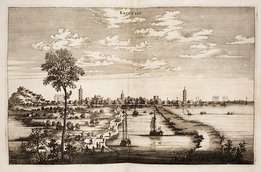Gaoyou
| Gaoyou 高邮市 | |
|---|---|
| County-level city | |
 Gaoyou Location in Jiangsu | |
| Coordinates: 32°50′42″N 119°30′29″E / 32.845°N 119.508°ECoordinates: 32°50′42″N 119°30′29″E / 32.845°N 119.508°E[1] | |
| Country | People's Republic of China |
| Province | Jiangsu |
| Prefecture-level city | Yangzhou |
| Area | |
| • Total | 1,963 km2 (758 sq mi) |
| Population (2000) | |
| • Total | 830,000 |
| • Density | 420/km2 (1,100/sq mi) |
| Time zone | China Standard (UTC+8) |
| Postal code | 225600 |
| Area code(s) | 0514 |

Gaoyou (simplified Chinese: 高邮; traditional Chinese: 高郵; pinyin: Gāoyóu; literally: "high post (stop)"), also known as Qinyou (simplified Chinese: 秦邮; traditional Chinese: 秦郵; pinyin: Qínyóu; literally: "Qín post stop"), is a county-level city under the administration of Yangzhou, Jiangsu province, China, located in the Yangtze River Delta on the north side of the Yangtze River. In 2000, it had a total topulation of 830,000 residing in 1,963 km2 (758 sq mi).
Administration
Gaoyou is a county-level city under the jurisdiction of Yangzhou prefecture-level city, and administers 19 towns and one township.
Towns
|
|
Township
- Lingtang Hui Ethnic Township (菱塘回族乡)
History
Gaoyou was founded in 223 BC, but recent archaeological finds at the Longqiuzhuang site in Gaoyou has found evidence of rice growing dating back 5,500-7,000 years. In 1375, early in the Ming Dynasty by the Hongwu Emperor, a post office was constructed called Yucheng You. At that time, it was one of the 46 important mail posts along the Grand Canal between Beijing and Nanjing. It was in use until the 1911 Revolution.
The profound history and culture of Gaoyou fostered Qin Shaoyou, the well-known poet in the Song Dynasty, Wang Nianshun and Wang Yinzhi (father and son), the celebrated classics interpreters in the Qing Dynasty, Sun Yunzhu, the modern paleontologist and Wang Chenqi, the contemporary writer.
Geography
Gaoyou is located at 32° 47' N, 119° 25' E in the southern part of the Jianghuai Plain, 40 kilometres (25 mi) north of Yangzhou on the east shore of Gaoyou Lake, while its administrative area reaches into the northern end of Shaobo Lake (邵伯镇). The Beijing-Shanghai expressway and the Grand Canal of China run though the city center from the north to the south.
Geology
Gaoyou is relatively flat with an elevation of 2 to 3 meters. The ground is mostly made up of clay. There is, however, an extinct basaltic volcano, named Shenju Hill (Shenjushan), in Tianshan Town.
Tourism
1. The Yucheng Post and Museum (in Chinese) A postal stop in Qing dynasty (221 BC). It was built as a post station in AD 1375. Largest and oldest historic post-office in the world.picture.
2. The Wenyou Platform (in Chinese) Built in AD 976 to memorize Qin Shaoyou, a well-known poet of the Song Dynasty. picture.
3.Longqiu Village (in Chinese) 7000-year history, area of 43,000 square meters. picture.
4.People's Plaza (AD 2002), Kuixing Pavilion (AD 971, high 20 m, 3 stories) and City Wall (AD 1623), Jingtusi Pagoda (Built in AD 1612, height 30 meters, 7 stories) and Zhenguosi Pagoda (Built in AD 873-889, height 34 m, 7 stories). An odd number of stories is considered yang based on the philosophy of Yin and Yang.
5.Wang's museum (in Chinese) Wang Nianshun (1744–1834,Father) and Wang Yinzhi (1766–1834, son), Masters in Confucian Philosophy and Classic literatures. picture.
Economy
Gaoyou has a very fast growing economy. It is home to approximately 3,000 industrial enterprises, most of which belong to the following sectors: machinery, light industry, textile, mechanical industry, building materials, and electronics.
Agriculture plays a large part in the overall economy of the region. The well-known feature product is "double yolk duck egg".
See also
References
- ↑ Google (2014-07-02). "Gaoyou" (Map). Google Maps. Google. Retrieved 2014-07-02.
External links
| Wikivoyage has a travel guide for Gaoyou. |
- Gaoyou Information Website
- Gaoyou City English guide
- (English) (Chinese) "Illustrated Album of Yangzhou Prefecture", from 1573-1620, has illustrations of Gaoyou